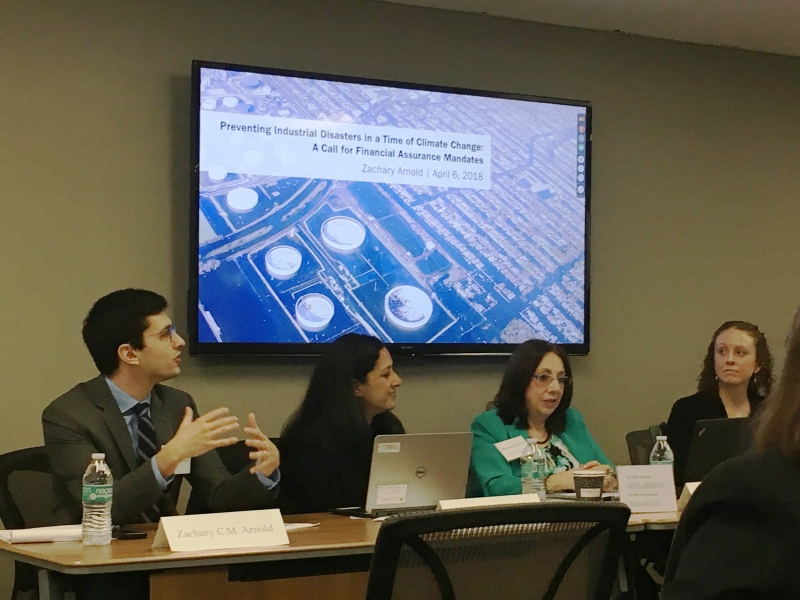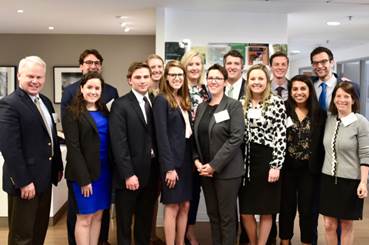Some of the smartest people in our law school classes became law professors. But, chances are you don’t know much, if anything, about their academic work. Busy policymakers and legal practitioners simply don’t have the time to read long, heavily footnoted law review articles. Yet, buried in those dense law review articles can be important new and creative law and policy proposals. All too often, however, academics talk about those ideas among themselves, and their proposals are not informed by policymakers, let alone adopted in the law and policy arena.
To help bridge the gap between academic scholarship and environmental law practice and policymaking, each year, Vanderbilt University Law School (VULS) students and ELI staff select some of the best articles in the legal environmental scholarship from the previous year. The selection process is part of a class taught by ELI Senior Attorney Linda Breggin and Vanderbilt Law Professor Michael Vandenbergh. The students work in collaboration with ELI Research Associate John Hare-Grogg, Environmental Law Reporter (ELR) Editor-in-Chief Jay Austin, and ELI Director of Communications and Publications Rachel Jean-Baptiste to select articles that offer creative, persuasive, and feasible law and policy proposals. The methodology used is available here. After the students have narrowed the articles down to a pool of about 20, they meet with an expert advisory committee of environmental professionals who provide input on the articles.
 Following article selection, ELI and VULS recruit expert commenters for each article from government, nongovernmental organizations, law firms, and corporations. ELI then convenes the authors and commenters at the Environmental Law and Policy Annual Review Conference at ELI to discuss and evaluate the creative proposals presented in the articles. Vanderbilt Law School students introduce the panels and explain the article selection process. The conference is typically attended by a range of stakeholders, including Capitol Hill and federal agency staff, trade press, law firm associates and partners, and nonprofit leaders.
Following article selection, ELI and VULS recruit expert commenters for each article from government, nongovernmental organizations, law firms, and corporations. ELI then convenes the authors and commenters at the Environmental Law and Policy Annual Review Conference at ELI to discuss and evaluate the creative proposals presented in the articles. Vanderbilt Law School students introduce the panels and explain the article selection process. The conference is typically attended by a range of stakeholders, including Capitol Hill and federal agency staff, trade press, law firm associates and partners, and nonprofit leaders.
The project culminates in a joint ELI/VULS publication, the August issue of ELR’s News & Analysis. It includes condensed versions of the selected articles and short written pieces by the commenters. The 2017 issue can be found here—or you can subscribe and obtain this year’s ELPAR issue when it is published in August.
Ultimately, seven articles will be recognized in the August 2018 issue of News & Analysis. The following articles were presented at the conference in Washington, D.C. (the full agenda, including the commenters, is available here):
- Preventing Industrial Disasters in a Time of Climate Change: A Call for Financial Assurance Mandates by Zachary C.M. Arnold (originally published in the Harvard Environmental Law Review). Mr. Arnold argues that financial assurance mandates or FAMs, such as insurance requirements, should be a central element of climate adaptation policy because coastal industries are underinvesting in reducing the risks their operations pose, and because most common coastal climate adaptation regulatory approaches, such as zoning and building codes and adaptation subsidy programs, have serious drawbacks.
- Visual Rulemaking by Elizabeth G. Porter and Kathryn A. Watts (originally published in the New York University Law Review). The professors posit that the use of visuals by agencies and other key stakeholders in the rulemaking process should be encouraged, as well as included as part of the administrative record, in order to democratize the system by promoting transparency, political accountability, and increased public participation.
- Impact Transaction: Lawyering for the Public Good Through Collective Impact Agreements by Patience A. Crowder (originally published in the Indiana Law Review). Crowder proposes that nonprofit organizations, public entities (including state and local governments), educational institutions, the private sector, and representatives of the targeted community should create “impact transactions” that leverage public and private resources to address large-scale societal problems, including environmental degradation, using new tools, including a collective impact initiative roadmap and an outline for the collective impact contract process that is based on relational contract theory.
In addition, a fourth article was discussed at a symposium on March 12, 2018, at Vanderbilt Law School. In his article, Relative Administrability, Conservatives, and Environmental Regulatory Reform, Prof. Blake Hudson proposes that state and local policies that employ geographic delineations or line drawing, such as environmental buffers and growth boundaries, provide opportunities for conservatives to support environmental protection goals while reducing the size, scope, and cost of the federal bureaucracy.
Finally, ELI held a public webinar on April 9, which showcased a fifth article, Managing the Future of the Electricity Grid: Distributed Generation and Net Metering, by Richard L. Revesz and Burcin Unel (originally published in the Harvard Environmental Law Review). Dr. Unel’s and Professor Revesz’s thesis is that an “Avoided Cost Plus Social Benefit” protocol should be adopted for net metering of distributed energy generation, whereby clean distributed energy is rewarded for its environmental and health benefits and utilities are compensated for the services they provide—until more comprehensive energy reform can be achieved that ensures the efficient integration of all types of distributed energy into the grid.
 Video recordings of the conference and webinar are posted on the ELI and Vanderbilt University Law School ELPAR web pages.
Video recordings of the conference and webinar are posted on the ELI and Vanderbilt University Law School ELPAR web pages.
Notably, two additional articles were selected for honorable mention: Precautionary Federalism and the Sharing Economy by Sarah Light (originally published in the Emory Law Journal), and Hybridizing Law: A Policy for Hybridization Under the Endangered Species Act by John Erwin (originally published in the Environmental Law Reporter). In the former article, Light argues that a new “precautionary federalism” principle should be adopted by agencies, courts, and legislatures that allows all levels of government to regulate the sharing economy in the near term, in an effort to garner sufficient information to determine the economic and environmental impacts of the sharing economy and which level(s) of government are best situated to regulate it. In the latter article, Erwin proposes that, in determining whether hybrid populations should be protected under the Endangered Species Act, the U.S. Fish and Wildlife Service and the National Marine Fisheries Service should adopt a policy that uses a two-factor test that considers whether protection of hybrid organisms: (1) preserves an endangered taxon; and (2) benefits the ecosystem as a whole.
Look for the August issue of ELR's News & Analysis this summer to learn more about these creative ideas from the legal academy!

